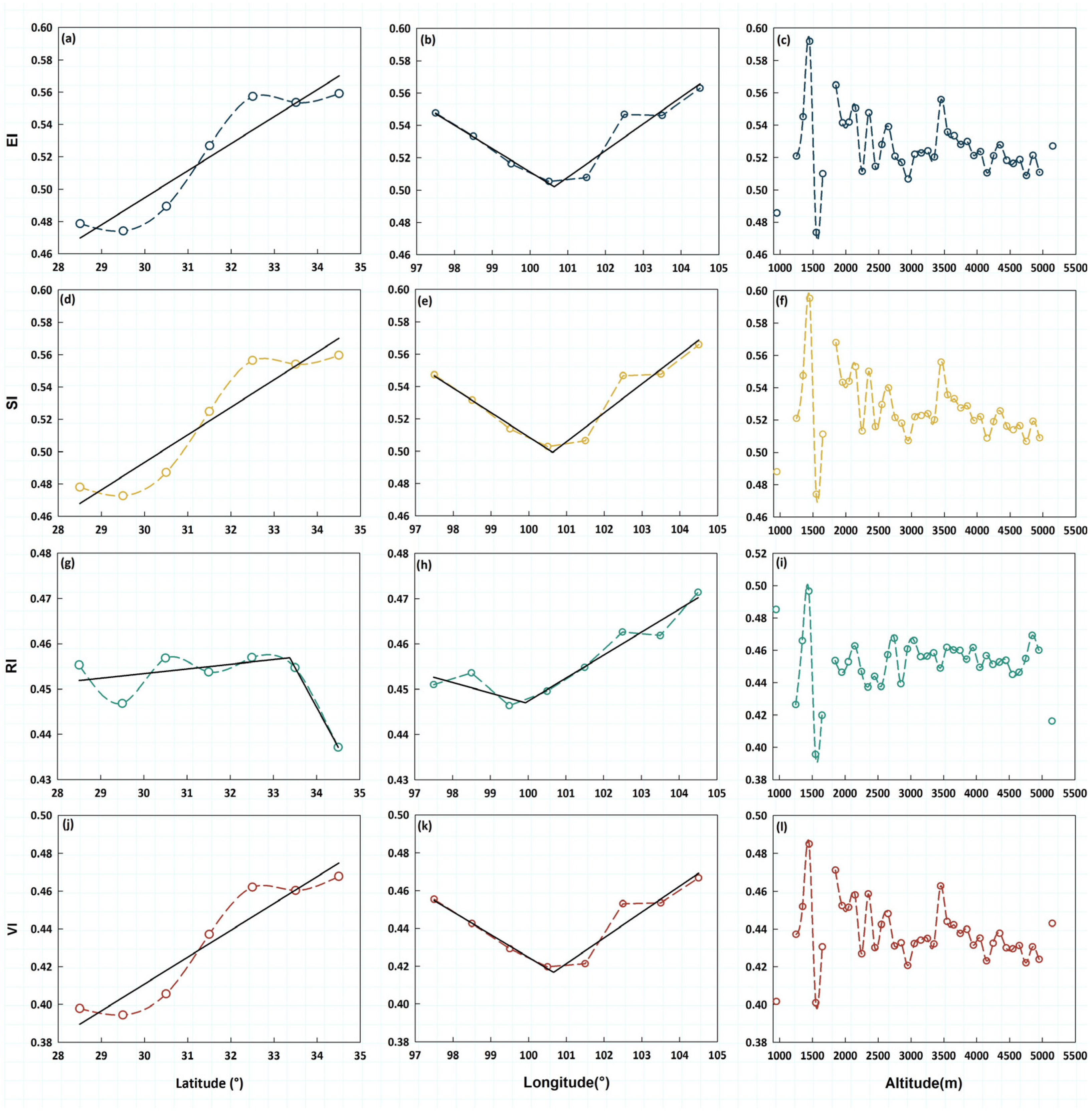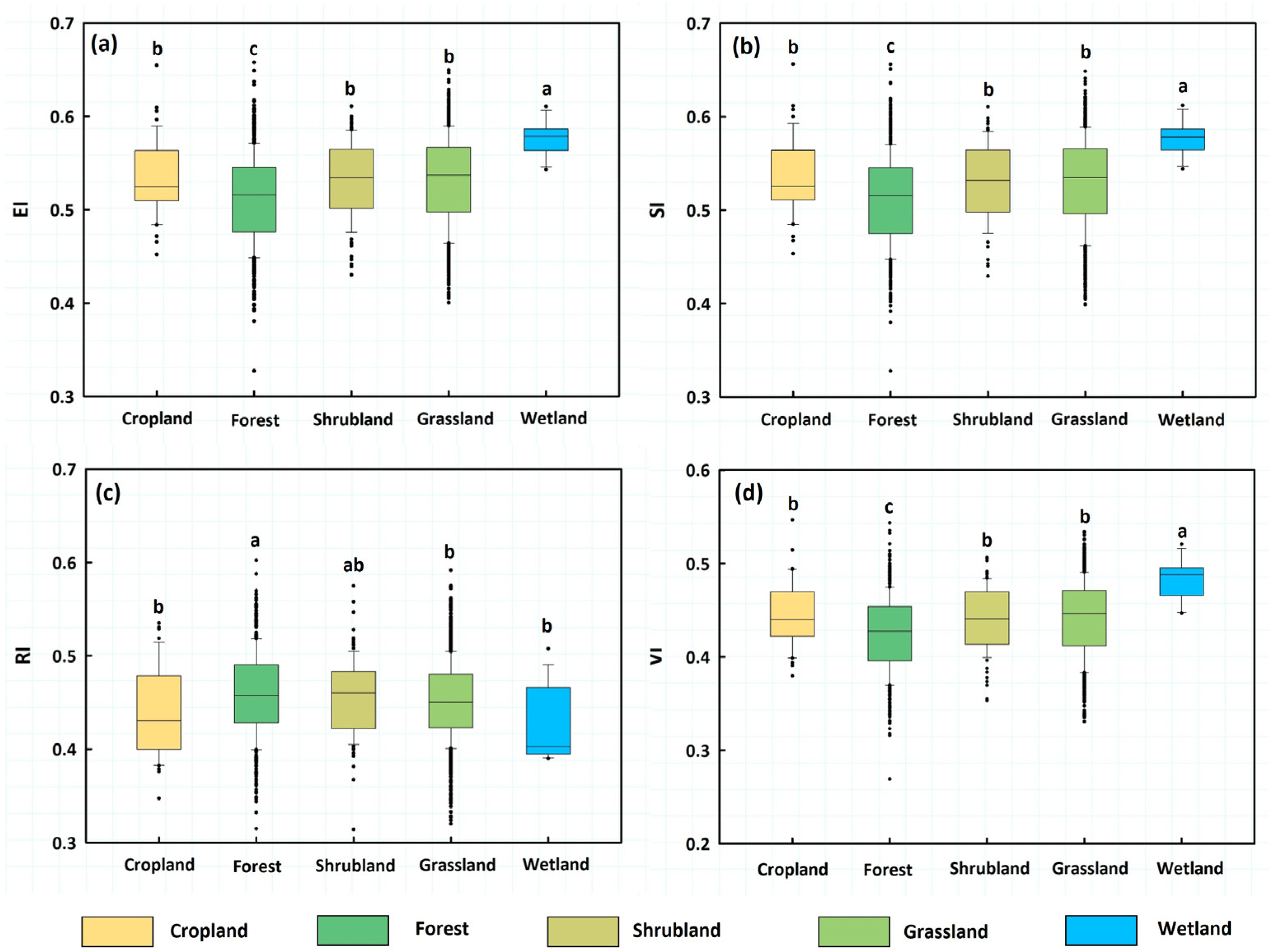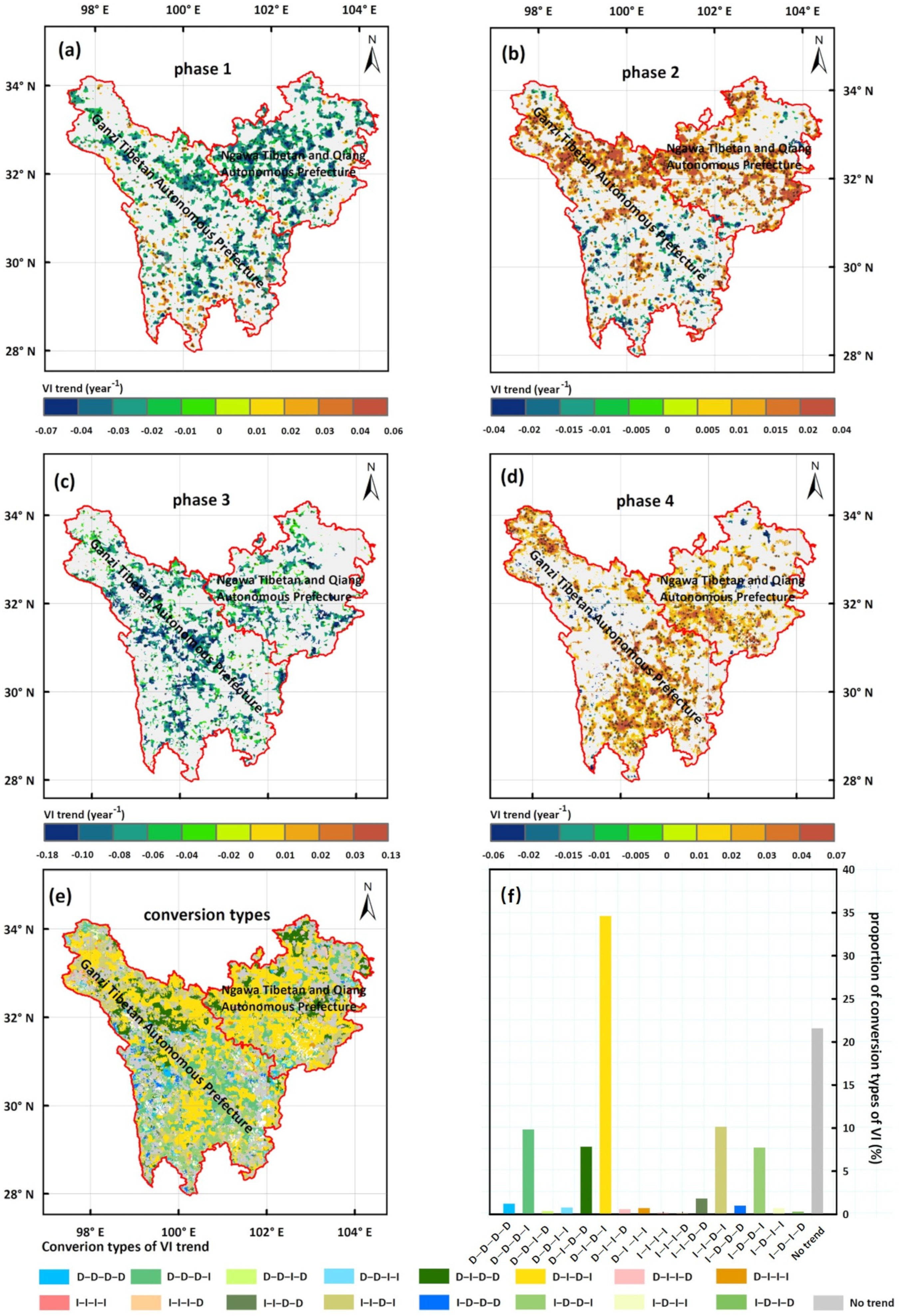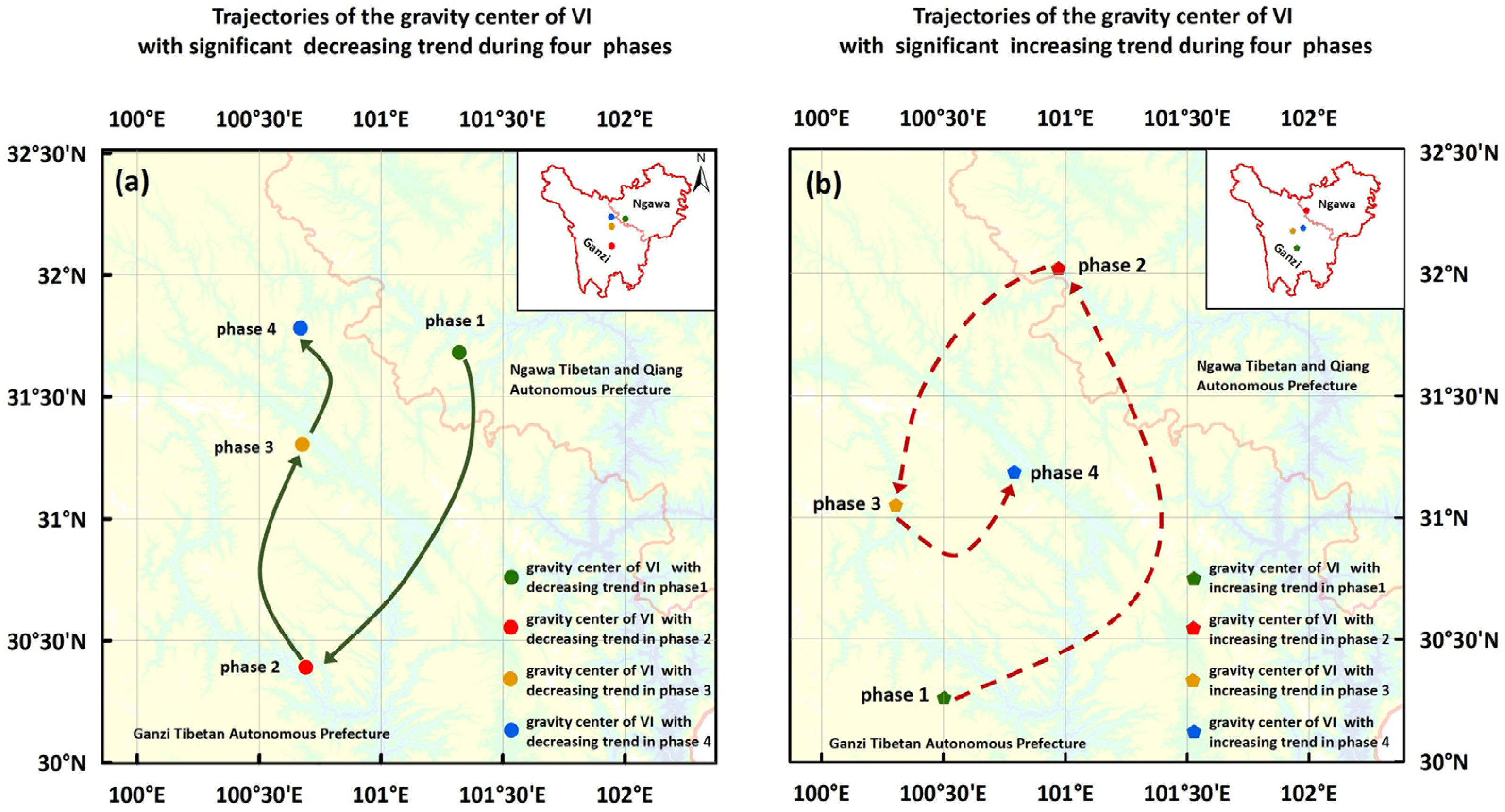Spatiotemporal Dynamics of Ecological Vulnerability to Climate Change in Northwestern Sichuan’s Terrestrial Ecosystems of China: Conservation Implications
Simple Summary
Abstract
1. Introduction
2. Materials and Methods
2.1. Study Area
2.2. Methods
2.2.1. Data Sources and Preprocessing
- Data Sources
- Data preprocessing
2.2.2. Ecological Vulnerability Assessment Model
- Overview of the ecological vulnerability
- Resilience, Sensitivity and Exposure
2.2.3. Statistical Analysis Methods
3. Results
3.1. Spatial Distribution Characteristics of TENS Vulnerability
3.1.1. Spatial Patterns of VI
3.1.2. Zonal Characteristics of VI
3.1.3. Comparative Analysis of VI Across Ecosystem Types
3.2. Temporal Dynamics of TENS Vulnerability
3.2.1. Interannual Variations in Vulnerability from 1985 to 2020
3.2.2. Spatial Heterogeneities of Phase-Specific Interannual Variations in Vulnerability
- Phase 1 (1985–1994): Significant VI decreases (indicating reduced vulnerability and improved ecosystem quality) occurred in 27.76% of the TENS, particularly in western Aba Tibetan and Qiang Autonomous Prefecture. Significant increases (suggesting heightened vulnerability) were limited to 4.76% of the region. The majority (67.48%) showed no significant trend (Figure 6a, Table S1).
- Phase 2 (1994–2008): Significant VI increases (indicating increased vulnerability and ecosystem degradation) covered 31.43% of the region, mainly in northern Ganzi Tibetan Autonomous and Aba Tibetan and Qiang Autonomous Prefectures. Significant decreases were observed in 7.23% of the region. No significant trend dominated in 61.34% of the area (Figure 6b, Table S1).
- Phase 3 (2008–2011): Significant VI decreases (reflecting improved ecosystem quality) were widespread in 24.89% of the region. Significant increases were minimal, with small areas scattered throughout the northern Ganzi Tibetan Autonomous Prefecture and the Ganzi–Aba border. No significant trend was evident in 75.11% of the region (Figure 6c, Table S1).
- Phase 4 (2011–2020): Significant VI increases (indicating ecosystem degradation) occurred in 33.31% of the region, concentrated in central and southeastern TENS. Significant decreases (suggesting ecosystem improvement) were limited to 1.38% of the region, mainly in northern and western TENS. No significant trend prevailed in 65.31% of the area (Figure 6d, Table S1).
3.2.3. Spatial Migration Dynamics of Vulnerability Changing Trends
4. Discussion
4.1. Spatial Heterogeneities and Ecosystem-Specific Vulnerabilities
4.2. Interannual Dynamics of TENS Vulnerabilities
4.3. Policy and Management Recommendations
- Targeted conversation efforts in high-risk zones
- Adaptive management for ecosystem-specific vulnerabilities
- Incorporating climatic variability into land use planning
- Enhancement of ecological monitoring and data collection
- Policy integration and multi-stakeholder involvement
4.4. Limitations and Future Research Directions
5. Conclusions
Supplementary Materials
Author Contributions
Funding
Institutional Review Board Statement
Informed Consent Statement
Data Availability Statement
Acknowledgments
Conflicts of Interest
Abbreviations
| TENS | the terrestrial ecosystems of Northwestern Sichuan |
| MAT | mean annual temperature |
| AP | annual precipitation |
| AI | aridity index |
| VI | vulnerability index |
| EI | exposure index |
| SI | sensitivity index |
| RI | resilience index |
References
- The Intergovernmental Panel on Climate Change (IPCC). Climate Change 2021: The Physical Science Basis; IPCC Sixth Assessment Report; IPCC: Geneva, Switzerland, 2021. [Google Scholar]
- The Intergovernmental Panel on Climate Change (IPCC). Climate Change 2022: Impacts, Adaptation and Vulnerability; IPCC Sixth Assessment Report; IPCC: Geneva, Switzerland, 2022. [Google Scholar]
- Jiang, W.; Shu, Z.; Lv, Y.; Su, X.; Wu, X.; Wang, C.; Wang, K.; Sun, S.; Liu, G. Quantifying impacts of climate and land use changes on ecosystem services from statistic perspective. Ecol. Indic. 2025, 172, 113285. [Google Scholar] [CrossRef]
- Schmeller, D.S.; Urbach, D.; Bates, K.; Catalan, J.; Cogălniceanu, D.; Fisher, M.C.; Friesen, J.; Füreder, L.; Gaube, V.; Haver, M.; et al. Scientists’ warning of threats to mountains. Sci. Total Environ. 2022, 853, 158611. [Google Scholar] [CrossRef]
- Zhang, X.; Zheng, Y.; Yang, Y.; Ren, H.; Liu, J. Spatiotemporal evolution of ecological vulnerability on the Loess Plateau. Ecol. Indic. 2025, 170, 113060. [Google Scholar] [CrossRef]
- Weißhuhn, P.; Müller, F.; Wiggering, H. Ecosystem vulnerability review: Proposal of an interdisciplinary ecosystem assessment approach. Environ. Manag. 2018, 61, 904–915. [Google Scholar] [CrossRef]
- Huang, L.; Xiao, J.T.; Zhou, Z.Q.; Ren, P. Study on the Evolution of the Mountain Ecological Environment Based on Remote Sensing and Water Footprints: Case Study of Northwestern Sichuan, Southwest China. Remote Sens. 2024, 16, 4412. [Google Scholar] [CrossRef]
- Fuchs, S.; Glade, T. Foreword: Vulnerability assessment in natural hazard risk—A dynamic perspective. Nat. Hazard. 2016, 82, 1–5. [Google Scholar] [CrossRef]
- Peng, Y.; Welden, N.; Renaud, F.G. A framework for integrating ecosystem services indicators into vulnerability and risk assessments of deltaic social-ecological systems. J. Environ. Manag. 2023, 326, 116682. [Google Scholar] [CrossRef]
- Gaughan, A.E.; Stevens, F.R.; Pricope, N.G.; Hartter, J.; Cassidy, L.; Salerno, J. Operationalizing vulnerability: Land system dynamics in a transfrontier conservation area. Land 2019, 8, 111. [Google Scholar] [CrossRef]
- Li, D.; Wu, S.; Liu, L.; Zhang, Y.; Li, S. Vulnerability of the global terrestrial ecosystems to climate change. Glob. Chang. Biol. 2018, 24, 4095–4106. [Google Scholar] [CrossRef]
- Kling, M.M.; Auer, S.L.; Comer, P.J.; Ackerly, D.D.; Hamilton, H. Multiple axes of ecological vulnerability to climate change. Glob. Chang. Biol. 2020, 26, 2798–2813. [Google Scholar] [CrossRef]
- Sang, Z.; Hamann, A. Climatic limiting factors of North American ecosystems: A remote-sensing based vulnerability analysis. Environ. Res. Lett. 2022, 17, 094011. [Google Scholar] [CrossRef]
- Xu, K.; Wang, X.P.; Jiang, C.; Sun, O.J.X. Assessing the vulnerability of ecosystems to climate change based on climate exposure, vegetation stability and productivity. For. Ecosyst. 2020, 7, 23. [Google Scholar] [CrossRef]
- Cai, X.; Li, Z.; Liang, Y. Tempo-spatial changes of ecological vulnerability in the arid area based on ordered weighted average model. Ecol. Indic. 2021, 133, 108398. [Google Scholar] [CrossRef]
- Li, H.; Song, W. Spatiotemporal distribution and influencing factors of ecosystem vulnerability on Qinghai-Tibet Plateau. Int. J. Environ. Res. Public Health 2021, 18, 6508. [Google Scholar] [CrossRef]
- Nandintsetseg, B.; Boldgiv, B.; Chang, J.; Ciais, P.; Davaanyam, E.; Batbold, A.; Bat-Oyun, T.; Stenseth, N.C. Risk and vulnerability of Mongolian grasslands under climate change. Environ. Res. Lett. 2021, 16, 034035. [Google Scholar] [CrossRef]
- Xiao, H.; Shao, H.; Long, J.; Zhang, S.; He, S.; Wang, D. Spatial-temporal pattern evolution and geological influence factors analysis of ecological vulnerability in Western Sichuan mountain region. Ecol. Indic. 2023, 155, 110980. [Google Scholar] [CrossRef]
- Yan, W.; Chen, H.; Wang, S.; Li, Z.; Wang, Y.; Li, S.; Sun, R. The construction and control policy of the ecological spatial pattern of the provincial sub-regions: A case study of Northwestern Sichuan. Shanghai Urban Plan. Rev. 2021, 3, 8–17. (In Chinese) [Google Scholar]
- Zhang, H. A Study on the characteristics of climate change on Northwestern Sichuan Plateau. J. Southwest Univ. Nat. Sci. Ed. 2014, 36, 148–156. (In Chinese) [Google Scholar]
- Yang, J.; Huang, X. The 30 m annual land cover datasets and its dynamics in China from 1985 to 2023. Earth Syst. Sci. Data 2024, 13, 3907–3925. [Google Scholar] [CrossRef]
- Peng, S.; Ding, Y.; Liu, W. 1 km monthly temperature and precipitation dataset for China from 1901 to 2017. Earth Syst. Sci. Data 2019, 11, 1931–1946. [Google Scholar] [CrossRef]
- Li, M.; Sen, C.; Zhu, Z.; Wang, Z.; Myneni, R.; Piao, S. Spatiotemporally consistent global dataset of the GIMMS Normalized Difference Vegetation Index (PKU GIMMS NDVI) from 1982 to 2022. Earth Syst. Sci. Data 2023, 15, 4181–4203. [Google Scholar] [CrossRef]
- Jiao, W.; Wang, L.; Smith, W.K.; Chang, Q.; Wang, H.; D’Odorico, P. Observed increasing water constraint on vegetation growth over the last three decades. Nat. Commun. 2021, 12, 3777. [Google Scholar] [CrossRef]
- Tang, J.; Niu, B.; Fu, G.; Peng, J.; Hu, Z.; Zhang, X. Shifted trend in drought sensitivity of vegetation productivity from 1982 to 2020. Agric. For. Meteorol. 2025, 362, 110388. [Google Scholar] [CrossRef]
- Yao, Y.; Liu, Y.; Fu, F.; Song, J.; Wang, Y.; Han, Y.; Wu, T.; Fu, B. Declined terrestrial ecosystem resilience. Glob. Chang. Biol. 2024, 30, e17291. [Google Scholar] [CrossRef]
- Loarie, S.R.; Duffy, P.B.; Hamilton, H.; Asner, G.P.; Field, C.B.; Ackerly, D.D. The velocity of climate change. Nature 2009, 462, 1052–1055. [Google Scholar] [CrossRef]
- Seddon, A.W.R.; Macias-Fauria, M.; Long, P.R.; Benz, D.; Willis, K.J. Sensitivity of global terrestrial ecosystems to climate variability. Nature 2016, 531, 229–232. [Google Scholar] [CrossRef]
- Turner, B.L.; Kasperson, R.E.; Matson, P.A.; McCarthy, J.J.; Corell, R.W.; Christensen, L.; Eckley, N.; Kasperson, J.X.; Luers, A.; Martello, M.L.; et al. A framework for vulnerability analysis in sustainability science. Proc. Natl. Acad. Sci. USA 2003, 100, 8074–8079. [Google Scholar] [CrossRef]
- Ippolito, A.; Sala, S.; Faber, J.H.; Vighi, M. Ecological vulnerability analysis: A river basin case study. Sci. Total Environ. 2010, 408, 3880–3890. [Google Scholar] [CrossRef]
- Zhang, Q.; Wang, G.; Yuan, R.; Singh, V.P.; Wu, W.; Wang, D. Dynamic responses of ecological vulnerability to land cover shifts over the Yellow river Basin, China. Ecol. Indic. 2022, 144, 109554. [Google Scholar] [CrossRef]
- Zhang, Q.; Yuan, R.; Singh, V.P.; Xu, C.Y.; Fan, K.; Shen, Z.; Wang, G.; Zhao, J. Dynamic vulnerability of ecological systems to climate changes across the Qinghai-Tibet Plateau, China. Ecol. Indic. 2022, 134, 108483. [Google Scholar] [CrossRef]
- De Keersmaecker, W.; Lhermitte, S.; Tits, L.; Honnay, O.; Somers, B.; Coppin, P. A model quantifying global vegetation resistance and resilience to short-term climate anomalies and their relationship with vegetation cover. Glob. Ecol. Biogeogr. 2015, 24, 539–548. [Google Scholar] [CrossRef]
- Simoniello, T.; Lanfredi, M.; Liberti, M.; Coppola, R.; Macchiato, M. Estimation of vegetation cover resilience from satellite time series. Hydrol. Earth Syst. Sci. 2008, 12, 1053–1064. [Google Scholar] [CrossRef]
- Carpenter, S.R.; Cole, J.J.; Pace, M.L.; Batt, R.; Brock, W.A.; Cline, T.; Coloso, J.; Hodgson, J.R.; Kitchell, J.F.; Seekell, D.A.; et al. Early warnings of regime shifts: A whole-ecosystem experiment. Science 2011, 332, 1079–1082. [Google Scholar] [CrossRef] [PubMed]
- R Core Team. R: A Language and Environment for Statistical Computing, Version 4.4.1; R Foundation for Statistical Computing: Vienna, Austria, 2024. Available online: https://www.r-project.org/ (accessed on 20 January 2025).
- IBM. IBM SPSS Statistics for Windows, Version 27.0; IBM Corp.: Armonk, NY, USA, 2021. Available online: https://www.ibm.com/products/spss-statistics (accessed on 20 January 2025).
- Gong, H.; Wang, G.; Wang, X.; Kuang, Z.; Cheng, T. Trajectories of terrestrial vegetation productivity and its driving factors in China’s drylands. Geophys. Res. Lett. 2024, 51, 2024GL111391. [Google Scholar] [CrossRef]
- Esri. ArcGIS Desktop, Release 10.8; Environmental Systems Research Institute: Redlands, CA, USA, 2020. Available online: https://www.esri.com/en-us/arcgis/products/arcgis-desktop/overview (accessed on 20 January 2025).
- Li, J.L.; Wang, G.X.; Li, K.; Li, Y.; Guo, L.M.; Song, C.L. Impacts of climate change and freeze-thaw cycles on water and sediment fluxes in the headwater region of the Yangtze River, Qinghai-Tibet Plateau. Catena 2023, 227, 107112. [Google Scholar] [CrossRef]
- Gupta, A.K.; Nandy, S.; Nath, A.J.; Mehta, D.; Pandey, R. Spatially explicit climate change vulnerability assessment of ecological systems along altitudinal gradients in the Indian Himalayan region. Environ. Sustain. Indic. 2024, 22, 100377. [Google Scholar] [CrossRef]
- Zhu, Q.; Liu, Y.; Shao, T.; Luo, R.; Tan, Z. Role of the Tibetan Plateau in northern drought induced by changes in the subtropical westerly jet. J. Clim. 2021, 34, 4955–4969. [Google Scholar] [CrossRef]
- Fahrländer, S.F.; Wang-Erlandsson, L.; Pranindita, A.; Jaramillo, F. Hydroclimatic vulnerability of wetlands to upwind land use changes. Earths Future 2024, 12, e2023EF003837. [Google Scholar] [CrossRef]
- Mitchell, J.C.; Kashian, D.M.; Chen, X.W.; Cousins, S.; Flaspohler, D.; Gruner, D.S.; Johnson, J.S.; Surasinghe, T.D.; Zambrano, J.; Buma, B. Forest ecosystem properties emerge from interactions of structure and disturbance. Front. Ecol. Environ. 2023, 21, 14–23. [Google Scholar] [CrossRef]
- Huang, J.; Luo, Y.; Zhao, Z. Global warming and El Niño events. Adv. Clim. Chang. Res. 2023, 19, 663–666. (In Chinese) [Google Scholar]
- Xu, B.; Li, J.; Luo, Z.; Wu, J.; Liu, Y.; Yang, H.; Pei, X. Analyzing the spatiotemporal vegetation dynamics and their responses to climate change along the Ya’an-Linzhi section of the Sichuan-Tibet railway. Remote Sens. 2022, 14, 3584. [Google Scholar] [CrossRef]
- Yan, W.; Deng, D.; Yu, L.; Zhang, W.; Wu, B.; Guo, X.; Liu, Q. Discussion on technical issues related to desertified land control in Northwest Sichuan—A case study of sand control and desertification prevention projects in Northwest Sichuan. J. Sichuan For. Sci. Technol. 2015, 36, 62–68. (In Chinese) [Google Scholar]
- Pan, Z.; Gao, G.; Fu, B. Spatiotemporal changes and driving forces of ecosystem vulnerability in the Yangtze River Basin, China: Quantification using habitat-structure-function framework. Sci. Total Environ. 2022, 835, 155494. [Google Scholar] [CrossRef]







Disclaimer/Publisher’s Note: The statements, opinions and data contained in all publications are solely those of the individual author(s) and contributor(s) and not of MDPI and/or the editor(s). MDPI and/or the editor(s) disclaim responsibility for any injury to people or property resulting from any ideas, methods, instructions or products referred to in the content. |
© 2025 by the authors. Licensee MDPI, Basel, Switzerland. This article is an open access article distributed under the terms and conditions of the Creative Commons Attribution (CC BY) license (https://creativecommons.org/licenses/by/4.0/).
Share and Cite
Jiao, C.; Yi, X.; Luo, J.; Wang, Y.; Deng, Y.; Gou, J.; Luo, D. Spatiotemporal Dynamics of Ecological Vulnerability to Climate Change in Northwestern Sichuan’s Terrestrial Ecosystems of China: Conservation Implications. Biology 2025, 14, 1625. https://doi.org/10.3390/biology14111625
Jiao C, Yi X, Luo J, Wang Y, Deng Y, Gou J, Luo D. Spatiotemporal Dynamics of Ecological Vulnerability to Climate Change in Northwestern Sichuan’s Terrestrial Ecosystems of China: Conservation Implications. Biology. 2025; 14(11):1625. https://doi.org/10.3390/biology14111625
Chicago/Turabian StyleJiao, Cuicui, Xiaobo Yi, Ji Luo, Ying Wang, Yuanjie Deng, Jiangtao Gou, and Danting Luo. 2025. "Spatiotemporal Dynamics of Ecological Vulnerability to Climate Change in Northwestern Sichuan’s Terrestrial Ecosystems of China: Conservation Implications" Biology 14, no. 11: 1625. https://doi.org/10.3390/biology14111625
APA StyleJiao, C., Yi, X., Luo, J., Wang, Y., Deng, Y., Gou, J., & Luo, D. (2025). Spatiotemporal Dynamics of Ecological Vulnerability to Climate Change in Northwestern Sichuan’s Terrestrial Ecosystems of China: Conservation Implications. Biology, 14(11), 1625. https://doi.org/10.3390/biology14111625








